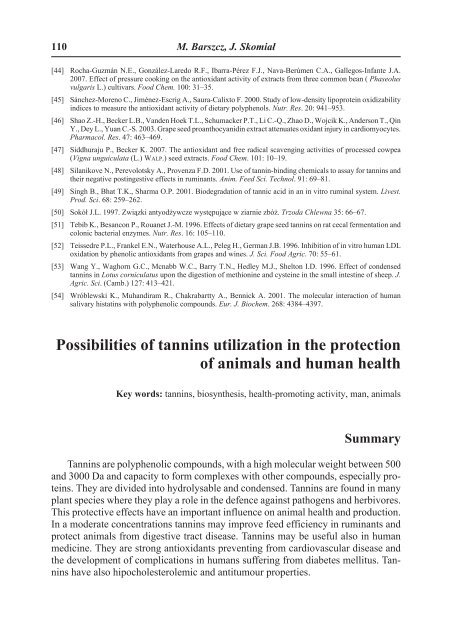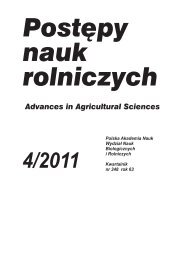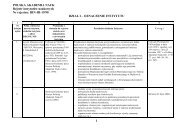Postepy nauk rolniczych - Instytucja Naukowa - Polska Akademia ...
Postepy nauk rolniczych - Instytucja Naukowa - Polska Akademia ...
Postepy nauk rolniczych - Instytucja Naukowa - Polska Akademia ...
You also want an ePaper? Increase the reach of your titles
YUMPU automatically turns print PDFs into web optimized ePapers that Google loves.
110 M. Barszcz, J. Skomia³<br />
[44] Rocha-Guzmán N.E., González-Laredo R.F., Ibarra-Pérez F.J., Nava-Berúmen C.A., Gallegos-Infante J.A.<br />
2007. Effect of pressure cooking on the antioxidant activity of extracts from three common bean ( Phaseolus<br />
vulgaris L.) cultivars. Food Chem. 100: 31–35.<br />
[45] Sánchez-Moreno C., Jiménez-Escrig A., Saura-Calixto F. 2000. Study of low-density lipoprotein oxidizability<br />
indices to measure the antioxidant activity of dietary polyphenols. Nutr. Res. 20: 941–953.<br />
[46] Shao Z.-H., Becker L.B., Vanden Hoek T.L., Schumacker P.T., Li C.-Q., Zhao D., Wojcik K., Anderson T., Qin<br />
Y., Dey L., Yuan C.-S. 2003. Grape seed proanthocyanidin extract attenuates oxidant injury in cardiomyocytes.<br />
Pharmacol. Res. 47: 463–469.<br />
[47] Siddhuraju P., Becker K. 2007. The antioxidant and free radical scavenging activities of processed cowpea<br />
(Vigna unguiculata (L.) WALP.) seed extracts. Food Chem. 101: 10–19.<br />
[48] Silanikove N., Perevolotsky A., Provenza F.D. 2001. Use of tannin-binding chemicals to assay for tannins and<br />
their negative postingestive effects in ruminants. Anim. Feed Sci. Technol. 91: 69–81.<br />
[49] Singh B., Bhat T.K., Sharma O.P. 2001. Biodegradation of tannic acid in an in vitro ruminal system. Livest.<br />
Prod. Sci. 68: 259–262.<br />
[50] Sokó³ J.L. 1997. Zwi¹zki antyod¿ywcze wystêpuj¹ce w ziarnie zbó¿. Trzoda Chlewna 35: 66–67.<br />
[51] Tebib K., Besancon P., Rouanet J.-M. 1996. Effects of dietary grape seed tannins on rat cecal fermentation and<br />
colonic bacterial enzymes. Nutr. Res. 16: 105–110.<br />
[52] Teissedre P.L., Frankel E.N., Waterhouse A.L., Peleg H., German J.B. 1996. Inhibition of in vitro human LDL<br />
oxidation by phenolic antioxidants from grapes and wines. J. Sci. Food Agric. 70: 55–61.<br />
[53] Wang Y., Waghorn G.C., Mcnabb W.C., Barry T.N., Hedley M.J., Shelton I.D. 1996. Effect of condensed<br />
tannins in Lotus corniculatus upon the digestion of methionine and cysteine in the small intestine of sheep. J.<br />
Agric. Sci. (Camb.) 127: 413–421.<br />
[54] Wróblewski K., Muhandiram R., Chakrabartty A., Bennick A. 2001. The molecular interaction of human<br />
salivary histatins with polyphenolic compounds. Eur. J. Biochem. 268: 4384–4397.<br />
Possibilities of tannins utilization in the protection<br />
of animals and human health<br />
Key words: tannins, biosynthesis, health-promoting activity, man, animals<br />
Summary<br />
Tannins are polyphenolic compounds, with a high molecular weight between 500<br />
and 3000 Da and capacity to form complexes with other compounds, especially proteins.<br />
They are divided into hydrolysable and condensed. Tannins are found in many<br />
plant species where they play a role in the defence against pathogens and herbivores.<br />
This protective effects have an important influence on animal health and production.<br />
In a moderate concentrations tannins may improve feed efficiency in ruminants and<br />
protect animals from digestive tract disease. Tannins may be useful also in human<br />
medicine. They are strong antioxidants preventing from cardiovascular disease and<br />
the development of complications in humans suffering from diabetes mellitus. Tannins<br />
have also hipocholesterolemic and antitumour properties.

















